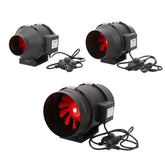How to Chose The Correct Type of Circuit Breaker
Choosing the correct type of circuit breaker is essential for ensuring the safety and reliability of your electrical system. Here's a step-by-step guide to help you make the right choice:
1. Determine the Electrical Load:
- Calculate the total electrical load of the circuit or equipment you're protecting. This includes the current (measured in amps) required by the connected devices.
2. Understand the Circuit Requirements:
- Identify the type of circuit you're working with, whether it's for residential, commercial, or industrial use.
- Consider the voltage rating of the circuit, typically 120V or 240V for residential circuits and higher for commercial and industrial applications.
3. Choose the Correct Amp Rating:
- Select a circuit breaker with an amp rating equal to or greater than the total electrical load of the circuit. Choosing a breaker with too low an amp rating can lead to frequent tripping, while one with too high a rating may not provide adequate protection.
4. Select the Right Type:
- Standard Circuit Breakers: These are the most common type and are designed to protect against overloads and short circuits. They are available in single-pole, double-pole, and triple-pole configurations.
- Ground Fault Circuit Interrupters (GFCIs): GFCIs are designed to protect against electrical shocks by quickly shutting off power when they detect a ground fault. They are typically required in areas where water is present, such as kitchens, bathrooms, and outdoor outlets.
- Arc Fault Circuit Interrupters (AFCIs): AFCIs are designed to detect and prevent electrical fires caused by arcing faults in wiring. They are typically required in bedrooms and other living areas to comply with building codes.
- Combination AFCI/GFCI Circuit Breakers: These combine the features of both AFCIs and GFCIs, providing protection against both electrical fires and shocks.
- Specialty Circuit Breakers: There are also specialized circuit breakers available for specific applications, such as motor protection, surge protection, and high-voltage circuits.
5. Consider Environmental Factors:
- If the circuit breaker will be installed in a harsh environment, such as outdoors or in a dusty or damp area, choose a breaker that is rated for those conditions.
6. Ensure Compatibility:
- Make sure the circuit breaker is compatible with the electrical panel or distribution board where it will be installed. Check the manufacturer's specifications to confirm compatibility.
7. Follow Local Codes and Regulations:
- Be sure to consult local building codes and regulations to ensure compliance with safety standards and requirements for circuit protection devices.
8. Seek Professional Advice if Necessary:
- If you're unsure about which type or size of circuit breaker to choose, don't hesitate to consult with a qualified electrician or electrical engineer for guidance.
By following these steps and considerations, you can select the correct type of circuit breaker to provide effective protection for your electrical system. Remember that safety should always be the top priority when working with electricity.






